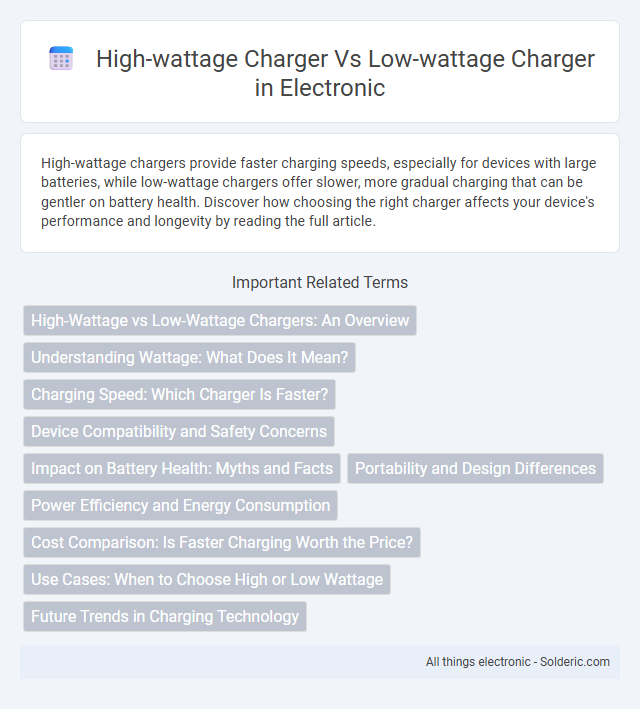High-wattage chargers provide faster charging speeds, especially for devices with large batteries, while low-wattage chargers offer slower, more gradual charging that can be gentler on battery health. Discover how choosing the right charger affects your device's performance and longevity by reading the full article.
Comparison Table
| Feature | High-Wattage Charger | Low-Wattage Charger |
|---|---|---|
| Power Output | Above 30W (e.g., 45W, 65W, 100W) | Below 30W (e.g., 5W, 10W, 18W) |
| Charging Speed | Fast charging, significantly reduces charge time | Slower charging, longer time to full charge |
| Device Compatibility | Supports fast-charging devices, laptops, tablets, smartphones | Suitable for basic phones, older devices, low-power gadgets |
| Heat Generation | May produce more heat during charging | Less heat generated, safer for extended use |
| Portability | Usually larger and heavier due to higher power components | Compact and lightweight, easy to carry |
| Cost | Higher price due to advanced technology | More affordable, budget-friendly |
| Use Case | Ideal for quick charging and high-power devices | Best for overnight charging and low-power devices |
High-Wattage vs Low-Wattage Chargers: An Overview
High-wattage chargers, typically ranging from 30W to 100W or more, provide rapid charging capabilities ideal for smartphones, laptops, and tablets, significantly reducing downtime. Low-wattage chargers, usually below 18W, deliver slower charging speeds but are often more compact and energy-efficient, suitable for maintaining battery life in smaller devices. Choosing between high and low-wattage chargers depends on device compatibility, charging speed requirements, and power efficiency preferences.
Understanding Wattage: What Does It Mean?
Wattage refers to the amount of electrical power a charger can deliver to a device per unit of time, measured in watts (W). High-wattage chargers typically provide faster charging speeds by supplying more power, ideal for devices with large batteries or quick charge capabilities. Low-wattage chargers deliver less power, resulting in slower charge times but often being more energy-efficient and suitable for smaller devices.
Charging Speed: Which Charger Is Faster?
High-wattage chargers deliver more power output, charging your devices significantly faster by supplying higher currents and voltages compared to low-wattage chargers. Devices compatible with fast-charging technology, such as USB Power Delivery or Qualcomm Quick Charge, maximize this advantage, reducing overall charging time. Your choice of charger impacts efficiency, especially for power-hungry smartphones, tablets, and laptops, where a high-wattage charger provides a quicker recharge cycle.
Device Compatibility and Safety Concerns
High-wattage chargers deliver faster charging speeds, but they require devices that support higher power input, such as laptops and modern smartphones with USB Power Delivery (USB-PD) compatibility. Low-wattage chargers are safer for older or smaller devices, like earbuds and basic phones, reducing the risk of overheating or battery damage. Using a charger with the correct wattage matching the device's specifications ensures optimal safety and prevents potential compatibility issues.
Impact on Battery Health: Myths and Facts
High-wattage chargers deliver more power for faster charging, but concerns about battery degradation are mostly myths; modern lithium-ion batteries and smart charging technologies regulate voltage and current to prevent damage regardless of wattage. Low-wattage chargers generate less heat during charging, which can theoretically extend battery life, but the difference in battery health impact compared to high-wattage chargers is minimal when proper charging protocols are followed. Scientific studies indicate that battery health depends more significantly on factors like temperature, charging cycles, and usage patterns than on charger wattage alone.
Portability and Design Differences
High-wattage chargers are generally bulkier and heavier due to larger components needed to handle higher power output, making them less portable for everyday carry compared to their low-wattage counterparts. Low-wattage chargers often feature compact, lightweight designs ideal for travel and on-the-go use, prioritizing ease of transport without sacrificing basic charging needs. Your choice depends on balancing portability with the power requirements of your devices, as high-wattage chargers excel in fast charging but may compromise convenience and size.
Power Efficiency and Energy Consumption
High-wattage chargers deliver faster charging speeds by providing higher power output, but they typically consume more energy during operation, which may reduce overall power efficiency compared to low-wattage chargers. Low-wattage chargers, while charging devices slower, tend to be more energy-efficient by minimizing power loss and heat generation, leading to lower electricity consumption over time. Choosing between high and low-wattage chargers depends on balancing the need for rapid charging against the goal of optimizing energy efficiency and reducing electricity costs.
Cost Comparison: Is Faster Charging Worth the Price?
High-wattage chargers often come with a higher upfront cost, but they significantly reduce charging time, enhancing convenience for users who need quick power boosts. Low-wattage chargers are more affordable but may result in longer device downtime, potentially impacting productivity or usage. Evaluating whether faster charging is worth the price depends on your daily device usage and the value you place on time savings versus initial investment.
Use Cases: When to Choose High or Low Wattage
High-wattage chargers are ideal for rapidly charging devices with large batteries, such as laptops, tablets, and high-capacity smartphones, saving valuable time when you need a quick power boost. Low-wattage chargers are best suited for smaller devices like wireless earbuds, smartwatches, or for slow charging overnight, preserving battery lifespan by delivering power gently. Choose your charger based on your device's power requirements and your charging speed preference to optimize performance and battery health.
Future Trends in Charging Technology
High-wattage chargers are driving the future of charging technology by enabling significantly faster battery replenishment, supporting the growing demand for quick device turnaround times in smartphones, laptops, and electric vehicles. Low-wattage chargers remain relevant for energy-efficient applications and prolonged battery health, addressing user needs in low-power devices and sustainable practices. Your choice between high- and low-wattage chargers aligns with trends in adaptive charging protocols and smart energy management systems that optimize power delivery based on device requirements.
High-wattage charger vs Low-wattage charger Infographic

 solderic.com
solderic.com